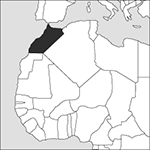
Source: MAPS IN MINUTES™ © RH Publications (1997)
Capital:
Rabat
Area:
446,550 sq km (172,414 sq miles)
Population:
32,649,130 (2013 est)
Currency:
1 dirham=100 centimes
Religions:
Muslim 99.0%; Christian 1.0%
Ethnic Groups:
Arab–Berber 99.0%
Languages:
Arabic, Tamazight (both official); other Berber languages; French
International Organizations:
UN; Non-Aligned Movement; Arab League; Maghreb Union; WTO
A country in the north-west corner of Africa bounded inland by Algeria and Western Sahara and with coasts on both the Mediterranean Sea and the Atlantic Ocean.
Physical
Much of Morocco consists of the Atlas Mountains, running from the south-west to the north-east. Near the coasts it is warm and wet; in the mountains, arid. South of the mountains begins the very hot and windy Sahara Desert. Rivers from the mountains water the coastal plains and permit a wide variety of crops.
Economy
Formerly dependent on the extraction and export of phosphates, of which Morocco has the world’s largest reserves, the economy has diversified, with agriculture and tourism now also important. Apart from phosphates, exports include clothing and textiles, electronic components, inorganic chemicals, oil products, and fruit and vegetables. Remittances from expatriates are important.
History
By the 5th century bc Phoenicians had stations on the Moroccan coast, when the Carthaginian admiral, Hanno, passed the Straits of Gibraltar, and perhaps reached the Gulf of Guinea. A kingdom of Mauritania was formed in northern Morocco in the 4th century bc; the Romans made it the province of Mauritania Tingitana, based on Tangier. Vandals from Spain occupied the region from 428, but the Berbers controlled the interior even after the Byzantines had recovered the coast in 533. It did not come under Arab control until Musa ibn Nusayr’s conquest in c.705. Under Byzantium the puritanism of the Berber character had been manifested in the Donatist heresy; under Islam a similarly austere movement, Kharijism, arose. True Arab domination was brief, and Berber dynasties emerged, Idrisids (788–974), Fatimids (909–73), Almoravids (1056–1147), Almohads (1145–1257), Merinids (1248–1548), and finally the Sharifian dynasties from 1524 until the present. Having defeated the Portuguese at Alcazarquivir (1578), Morocco itself attempted colonial expansion, defeating the Songhay empire with the help of firearms in 1591, but ruling it inefficiently.
By the 19th century, Morocco had lapsed into endemic disorder and became the target for French and Spanish imperial ambitions. In the early 20th century, German opposition to French expansionism produced serious international crises in 1905 and 1911 which almost resulted in war. In 1912 it was divided between a French protectorate, a Spanish protectorate, and the international Zone of Tangier. Rif rebels under Abd el-Krim fought the Spanish and French occupying powers in the 1920s, and Morocco became an independent monarchy under Muhammad V in 1956 when it absorbed Tangier. Muhammad was succeeded by his son Hassan II in 1961, but opposition sparked the suspension of parliamentary government in 1965, and royal authority was maintained in the face of abortive military coups in the early 1970s and intermittent republican opposition. In 1980 a new constitution proclaimed the kingdom of Morocco to be a constitutional monarchy. From the mid-1970s Morocco was involved in an inconclusive desert war in the former Spanish Sahara. A convention was signed in 1976 dividing this mineral-rich area between Morocco and Mauritania; but the latter renounced its claims in 1979 in favour of a nationalist group, the Polisario Front. Morocco annexed the land from which Mauritania had withdrawn, despite violent resistance from the Polisario Front. Major battles were fought in 1979 and 1980, and Moroccan troops built a series of desert walls. A ceasefire was negotiated in 1991, but little progress has been made in negotiations to secure a permanent peace accord. A new constitution, adopted in 1992, increased the powers of the government while retaining the hereditary monarch as head of state. A programme of privatization was launched in 1993. Hassan II was succeeded by his son Mohammed VI in 1999. In 2011 the Arab Spring inspired protests demanding further reform. Mohammed VI responded with a new constitution that again extended parliamentary and prime-ministerial powers but left the ultimate authority of the monarch intact, retaining control over all matters relating to religion, security, and major policy issues. Elections in 2012 resulted in Morocco’s first moderate Islamist government, and a further moderate coalition was formed in 2017, after elections in late 2016. In 2017 Morocco rejoined the African Union, which it had left in 1984 over policy differences on Western Sahara.
- Diffie Hellman key agreement
- diffraction
- diffraction grating
- diffraction limit
- diffraction of atoms
- diffraction pattern
- diffraction rings
- diffuse coevolution
- diffused junction
- diffuse interstellar bands
- diffuse nebula
- diffuse pollution
- diffuser
- diffuse reflection
- diffusion
- diffusion address
- diffusion cloud chamber
- diffusion coefficient
- diffusion constant
- diffusion-controlled growth
- diffusion creep
- diffusion current
- diffusion equation
- diffusion flame
- diffusion gradient